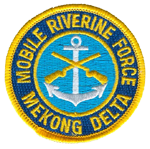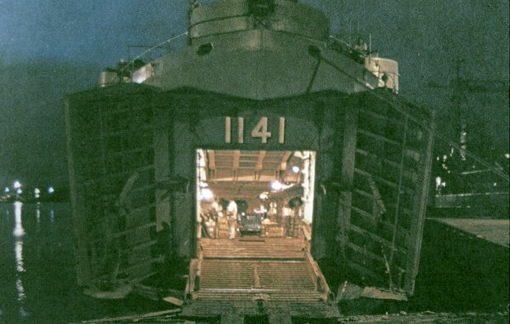
History of The USS Stone County (LST-1141)
February 23 , 2003
![]()
LST-1141 was laid down on 22 January 1945 by the Chicago Bridge and Iron Co., Seneca, Ill.; launched on 18 April; sponsored by Miss Gwendolyn K. Bartels; and commissioned on 9 May 1945, Lt. E. M. Biggs, USNR, in command.
After descending the Mississippi, LST-1141 moved from New Orleans to Mobile on 16 May and began her shakedown cruise which lasted from 17 to 31 May. Laden with cargo, she got underway on 16 June for California and arrived at San Pedro on 6 July. She sailed for Hawaii on 13 July and anchored in Pearl Harbor on 23 July. She headed west on 15 August and proceeded, via Eniwetok, to the Marianas arriving at Apra Harbor, Guam, on 31 August. On 5 September, she moved to Saipan. LST-1141 made a voyage to Tokyo, Japan, in early October and then operated in the Marianas until she returned to Pearl Harbor on 6 December enroute to the United States. She reached San Francisco on 22 December 1945 and operated along the California coast until May 1946.
LST-1141 stood out of San Diego on 2 May and headed for the western Pacific on what proved to be a two-year tour. She arrived at Shanghai, China, on 12 June; made a voyage to Sasebo, Japan; and returned to Tsingtao on the 27th. Thereafter, with the exception of occasional trips to Okinawa, Guam, or the Philippines, she operated along the China coast. On 15 April 1949, the ship departed Shanghai and proceeded–via Keelung, Taiwan; Subic Bay; and Pearl Harbor–to the United States. Upon her arrival at San Francisco on 4 June, she was ordered to report to the Pacific Reserve Fleet for inactivation. On 24 August 1949, LST-1141 was decommissioned and placed in reserve at San Diego.
The outbreak of hostilities in Korea in June 1950 created a need for additional shipping; and, on 7 August, orders were issued to reactivate LST-1141. The ship was recommissioned on 3 November 1950 at San Diego. After shakedown, refitting, and loading supplies, LST-1141 sailed for Japan on 21 March 1951; and she arrived at Yokosuka on 21 May 1951. During her service in the Far East, she participated in various troop landing exercises, hauled cargo from Japan to Korea, and participated in the “Royal Marine Lift” from Japan to Korea. On 10 February 1952, the ship departed Yokosuka for home.
LST-1141 arrived at San Diego on 8 March and operated along the California coast until 15 January 1953 when she again sailed for Japan, via Pearl Harbor; Guam; and Chichi Jima, Bonin Islands. She arrived at Yokosuka in late February, moved to Sasebo on 17 March, and sailed to an area off Korea (in Area “S”) where she remained from 20 March to 19 April. The ship refitted at Yokosuka from 22 April to 2 May when she steamed to Inchon. In June, she made a run from Yokosuka to Pusan. This pattern of operations, supply runs from Japan to ports in Korea, continued until November 1953 with little change in their routine. Notable exceptions were the 35 days that the LST spent in enemy-held Wonsan Harbor and her role in Operation “Big Switch”, the transportation of Korean prisoners of war from compounds at Koje Do to Inchon. When this lift was completed, the LST carried Chinese prisoners from Choju Do to Inchon where they were given the opportunity to choose between Communism and freedom.
She steamed out of Yokosuka on 10 December and sailed into San Diego on 20 December 1953. LST-1141 spent 1954 in operations along the west coast which included a yard overhaul and a trip to Vancouver, British Columbia. On 3 January 1955, she deployed to the Far East and, after a non-stop voyage, arrived at Yokosuka on 1 February. The ship was attached to the 7th Fleet and aided in the evacuation of the Tachen Islands.
On 5 April, LST-1141 and LST Division 11 sailed for California and arrived at San Diego on the 26th. She spent the remainder of 1955 in various training exercises with United States Marines at San Diego and Oceanside, Calif. On 1 July 1955, LST-1141 was named USS Stone County (LST-1141) to commemorate counties in Missouri, Arkansas, and Mississippi.
In January 1956, Stone County participated in an exercise at Makusin Bay, Unalaska Island. After 18 months operating along the west coast, she sailed on 13 August 1957 for another tour in the western Pacific. Shortly after her arrival at Yokosuka, the ship loaded marines at Camp McGill on 25 September and lifted them to Naha, Okinawa, before returning to Japan. Two brief exercises followed: one off Okinawa and one at Subic Bay in the Philippines. She departed Subic Bay on 3 January 1958 for Japan, making a port call at Hong Kong en route. The deployment ended on 1 April when the LST returned to San Diego.
Stone County was deployed with the 7th Fleet again from 23 April to 9 December 1959. In 1961, she participated in Operation “Silver Sword” conducted at Maui, Hawaii. In April 1962, the LST operated in the midPacific for the first of three 30-day periods to take part in the EASTPAC Survey. She provided logistic services for Air Force and Army survey teams. Detached in August, she carried soldiers of the 25th Infantry Division from Oahu to the island of Hawaii during September and returned to San Diego on 1 October 1962.
Stone County operated in the Hawaii area again from the fall of 1963 to January 1964 when she returned to the California coast. The ship was deployed to the western Pacific from late January 1965 to 7 May 1965.
Stone County embarked “A” Battery, 2d Light Antiaircraft Missile Battalion at San Diego during July 1965 and sailed for South Vietnam on 10 August. She arrived at Chu Lai on 12 September; offloaded the men, missiles, and their launching systems the next day; and sailed for Hong Kong. After port calls at Sasebo and Pearl Harbor, she returned to San Diego, arriving on 2 November. In December, she entered Todd Shipyard, San Pedro, Calif., for her regular overhaul, which lasted until 14 February 1966. After refresher and amphibious training, the LST took on troops and sailed for South Vietnam on 9 May, via Pearl Harbor and Subic Bay. She arrived at Chu Lai on 17 June and disembarked elements of the 9th Engineering Battalion, USMC, and sailed the next day for Japan. Stone County arrived at Yokosuka on 28 June and landed the remainder of her troops there. On 9 July, she sailed to Naha and loaded supplies for Danang, departing on the 14th. She arrived at Danang on 20 July and unloaded. From 21 July to 20 September, she operated between Danang and Chu Lai, transporting military cargo in support of American efforts in the I Corps area.
Stone County departed the operations area on 21 September en route to Sasebo for hull repairs. She returned to South Vietnam on 24 October with more cargo from Naha destined for Army forces at Qui Nhon. She commenced a voyage to Okinawa the next day where she loaded equipment to be returned to the United States. She sailed on 2 November, called at Pearl Harbor for two days, and arrived at San Diego on 2 December 1966.
Stone County operated out of her home port throughout 1967 and until March 1968. On 7 March, she got underway for the western Pacific, making port calls at Pearl Harbor, Saipan, Guam, and Subic Bay en route. The LST arrived at Danang on 25 April and operated along the coast until 13 June. After a short upkeep period in Subic Bay from 18 to 28 June, she returned to Danang for duty with the Naval Support Activity. She was on station from 3 to 28 July and then made a two-week trip to Hong Kong. The ship was back on station along the South Vietnamese coast from 10 August to 6 October. On 7 October, Stone County was detached to return to the United States and arrived at San Diego on 31 December 1968.
Stone County operated along the California coast until 23 October 1969 when she sailed for Guam, via Pearl Harbor. She arrived at Apra Harbor, her new home port, on 19 November 1969.
After an overhaul there, Stone County was transferred under lease to Thailand on 12 March 1970, and she served the Royal Thailand Navy as LANTA (LST-4). She was returned to the custody of the United States on 15 August 1973 and retransferred to the government of Thailand on the same date as a sale. Stone County was struck from the Navy list on 15 August 1973.
Stone County received (4) Battle Stars for Korean service.
[Renumbered to LST-714 between 1995 and 1997, LANTA was still on active duty with the Thai Navy as of May 1999.]
Awards earned during the Vietnam War: Combat Action Ribbon, RVN Gallantry Cross with Palm, RVN Campaign Medal with 60’s device and the Vietnam Service Medal with (5) Battle Stars.
This from former Commanding Officer Jim Giles
Greetings,
I was the last CO of LST 1141. Your web page for 1141 states:
“Stone County operated along the California coast until 23 October 1969 when she sailed for Guam, via Pearl Harbor. She arrived at Apra Harbor, her new home port, on 19 November 1969.”
The Navy did not intend to homeport the 1141 in Guam. Here is what actually happened.
I was part of Landing Ship Squadron 2 in Vung Tau in 1969. Because of the poor material condition of the ships in our squadron, the Squadron Commander dispatched me from Luzerne County, LST 902 to San Diego to pick up the 1141. I had a few enlisted men with me from the squadron. After we took custody of the ship in San Diego, the USS Papago towed us across the Pacific along with another LST. We stopped in Pearl on our way back to Vung Tau. Along the way, I discovered that some of the work supposedly performed on the 1141 in San Diego had, in fact, not been done. I reported this to CINCPAC while were in Pearl. We stopped again in Guam. By that time, I had documented a significant amount of other problems with the 1141 that would have made unable to perform her mission in Viet Nam. The higher-ups decided to overhaul 1141 at the SRF in Guam. We expected to return to Vung Tau after the overhaul. By early 1970, I think that the Vietnamization program was advanced to the point where the 1141 was not needed back in Viet Nam. So, we turned the ship over to the Royal Thai Navy. I returned to Viet Nam with my crew. There I served on the Page County and later the 902. The 902 returned to the US in March 1970 and was struck.
Jim Giles
Oriental, NC

